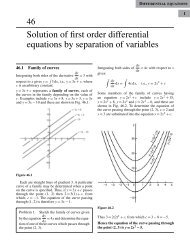vector
You also want an ePaper? Increase the reach of your titles
YUMPU automatically turns print PDFs into web optimized ePapers that Google loves.
Vectors 385<br />
Normal to (2), 2<br />
= (z – x 2 – y 2 + 3)<br />
=<br />
<br />
<br />
<br />
ˆ <br />
<br />
x y z<br />
ˆ ˆ 2 2<br />
i j k ( z– x – y 3)<br />
= – 2 x î – 2 y ĵ + ˆk<br />
Normal to (2) at (2, – 1, 2), 2<br />
= – 4î + 2 ĵ + ˆk ...(4)<br />
1.<br />
2 = | 1|| 2|cos<br />
<br />
1.<br />
2<br />
(4 iˆ –2ˆj 4 kˆ).(– 4iˆ 2 ˆj kˆ) –16 –44<br />
cos = =<br />
=<br />
| 1|| 2|<br />
|4 iˆ –2ˆj 4 kˆ||– 4iˆ 2 ˆj kˆ|<br />
16 416 16 41<br />
= –16 –8<br />
=<br />
6 21 3 21<br />
–1 –8 <br />
= cos <br />
3 21 <br />
–1 –8 <br />
Hence the angle between (1) and (2) cos <br />
Ans<br />
3 21 <br />
EXERCISE 5.6<br />
2<br />
3<br />
t<br />
t<br />
1. The coordinates of a moving particle are given by x = 4t and y = 3 6 t . Find the<br />
2<br />
6<br />
velocity and acceleration of the particle when t = 2 secs. Ans. 4.47, 2.24<br />
2. A particle moves along the curve<br />
x = 2t 2 , y = t 2 – 4t and z = 3t – 5<br />
where t is the time. Find the components of its velocity and acceleration at time t = 1, in the<br />
<br />
8 14 14<br />
direction i 3 j 2 k.<br />
(Nagpur, Summer 2001) Ans. , <br />
7 7<br />
3. Find the unit tangent and unit normal <strong>vector</strong> at t = 2 on the curve x = t 2 – 1, y = 4t – 3,<br />
z = 2t 2 – 6t where t is any variable.<br />
Ans.<br />
1 1 <br />
(2 i 2 j k), (2i 2 k)<br />
3 3 5<br />
<br />
d<br />
<br />
dG d F <br />
4. Prove that ( F G)<br />
F G<br />
dt dt dt<br />
<br />
5. Find the angle between the tangents to the curve 2 3<br />
r t i 2 t j t k,<br />
at the points t = ± 1.<br />
Ans. 1 9<br />
cos<br />
<br />
<br />
<br />
17<br />
<br />
6. If the surface 5x 2 – 2byz = 9x be orthogonal to the surface 4x 2 y + z 3 = 4 at the point (1, –1, 2)<br />
then b is equal to<br />
(a) 0 (b) 1 (c) 2 (d) 3 (AMIETE, Dec. 2009) Ans. (b)<br />
5.25 SCALAR AND VECTOR POINT FUNCTIONS<br />
Point function. A variable quantity whose value at any point<br />
N<br />
^<br />
in a region of space depends upon the position of the point, is<br />
R<br />
Q<br />
called a point function. There are two types of point functions.<br />
n r<br />
(i) Scalar point function. If to each point P (x, y, z) of a<br />
region R in space there corresponds a unique scalar f (P), then f is<br />
P<br />
called a scalar point function. For example, the temperature<br />
distribution in a heated body, density of a body and potential due to gravity are the examples of<br />
a scalar point function.<br />
(ii) Vector point function. If to each point P (x, y, z) of a region R in space there corresponds<br />
a unique <strong>vector</strong> f (P), then f is called a <strong>vector</strong> point function. The velocity of a moving fluid,<br />
gravitational force are the examples of <strong>vector</strong> point function.<br />
(U.P., I Semester, Winter 2000)<br />
= c<br />
<br />
+ d = c










